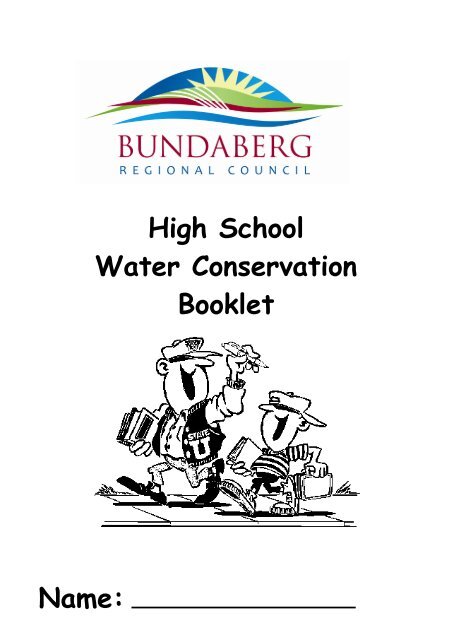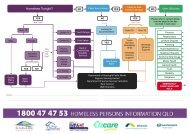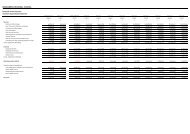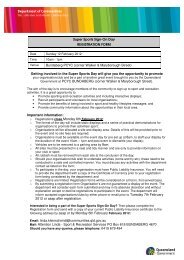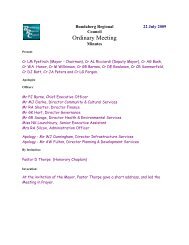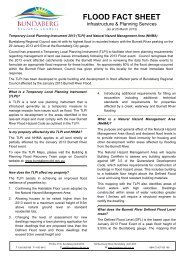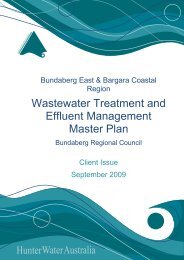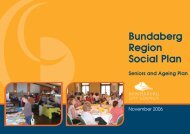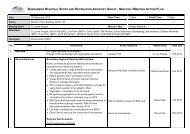High School Water Conservation Booklet Name: - Bundaberg ...
High School Water Conservation Booklet Name: - Bundaberg ...
High School Water Conservation Booklet Name: - Bundaberg ...
Create successful ePaper yourself
Turn your PDF publications into a flip-book with our unique Google optimized e-Paper software.
<strong>High</strong> <strong>School</strong><strong>Water</strong> <strong>Conservation</strong><strong>Booklet</strong><strong>Name</strong>:
There are many different ways we can interact with water,think about water and learn about water.This booklet will assist you to look and learn about water.Content:♦ Why <strong>Water</strong>♦ Drops of Wisdom About <strong>Water</strong>♦ Learn About <strong>Water</strong>♦ Seeing <strong>Water</strong> in Different Ways♦ The <strong>Water</strong> Cycle♦ Where in the World is <strong>Water</strong>♦ My Role in the Cycle♦ It’s Raining Inside♦ Juicy Fruit♦ The <strong>Water</strong>ing States of Matter♦ Catchments: down the slopes♦ Catchments: our waterways♦ Erosion Control♦ Why Dam?♦ From the Reservoir to the Tap♦ <strong>Water</strong> Flow and Pressure♦ <strong>Water</strong> Quality: water health and homes♦ <strong>Water</strong>way Pollutants: invisible♦ <strong>Water</strong>way Pollutants: visible♦ <strong>Water</strong>way Pollutants: suspended♦ <strong>Water</strong>way Pollutants: oxygen depleting♦ Home and Community <strong>Water</strong> Audit<strong>Water</strong> use survey<strong>Water</strong> use survey resultsOur water wise familyCommunity water survey♦ <strong>School</strong> <strong>Water</strong> AuditHow to read a water meter<strong>School</strong> water audit<strong>Water</strong> audit – boys toilet<strong>Water</strong> audit – girls toilet<strong>Water</strong> audit – staff amenities<strong>Water</strong> audit – amenities summary<strong>Water</strong> audit – classroom & canteen<strong>Water</strong> audit – bubblers<strong>Water</strong> audit – outdoor taps, Irrigationand cleaningDeveloping an action planMonitoring water usuage♦ Sewage Treatment♦ Settling the Sediments♦ <strong>Water</strong> Re-use♦ Going it Alone♦ Pipe Systems♦ Down the Plughole♦ How Can We Help?♦ Gutter Litter Survey♦ <strong>School</strong> Stormwater Plan♦ Developers♦ Catchment Upgrade♦ River to Tap2
Why <strong>Water</strong>?Why learn about water?As a class discuss the importance of water. Add to the following list from your discussions.♦ <strong>Water</strong> is essential for all living things.♦ <strong>Water</strong> is a natural precious resource in Australia and the world.♦ We all have an impact on the quality of our water.♦ <strong>Water</strong> is used in the community in many ways.♦ The natural environment has been changed to cater for people’s water needs.♦ The system we have created to collect and distribute water is very complex.♦♦♦♦♦♦♦♦♦♦3
Drops of Wisdom About <strong>Water</strong>Did you know:♦ Of all the water on Earth, 97% is saltwater, 2% is ice and only 1% is fresh water.♦ The amount of water on Earth has remained basically the same. We drink the same waterthe dinosaurs drank.♦ <strong>Water</strong> is the only natural substance that exists in three forms: liquid (water), gas(vapour) and solid (ice).♦ <strong>Water</strong> has no taste.♦ <strong>Water</strong> is colourless.♦ <strong>Water</strong> is odourless.♦ The boiling point for water is 100 o C.♦ The freezing point for water is 0 o C.♦ <strong>Water</strong> is made up of two hydrogen and one oxygen atoms, in other words H 2 O.♦ The three forms of water are important parts of the hydrological cycle (<strong>Water</strong> Cycle).This is the never ending cycle of water from the Earth’s surface to the atmosphere(evaporation) or from trees and plants (transpiration) to form clouds (condensation)before it falls back to Earth as rain, snow or hail (precipitation).♦ <strong>Water</strong> that exists in underground sources is called ground water – across Australia, bores(wells) have been dug so that people can ‘tap’ into these sources for their fresh watersupply.♦ A tap uses approximately 20 litres per hour – even a slow dripping tap will use five litresper hour.4
Learn About <strong>Water</strong>For one week collect newspaper and margazine articles that relate to water and waterissues. Make a list of these issues and the aspects of peoples lives that they effect.Sort these issues in relation to local, national and global implications and applications.Identify and discuss the environmental impact of these issues.LocalNationalGlobal5
Seeing <strong>Water</strong> in Different WaysMore precious that Gold.Every city in the world has been built around water. In small groups look at an atlas orconduct a web search and see which of the major cities around the world are built around ornear a major river or sea. How precious does this make water?For milions of years humans have lived around water, played in water, have drunk water andhad water fights in summer. A lot of our food has also come from water. What is it aboutwater that attracts us? In some cultures the sound of running water is thought to have aspiritual and relaxing effect. All religions use water in some way.Research the use of water by one of the following cultures:♦ Indian people and their relationships with the Ganges River.♦ African villages and wells.♦ Amazon river tribes.♦ The Nile River in Africa6
The <strong>Water</strong> CycleThe <strong>Water</strong> Cycle is one of the great ecological systems on the planet.Quantities of rainfall are matched by climate and create the rivers, lakesand oceans, which provide the source for the cycle to begin over again.Using the correct words finish these sentences.1. <strong>Water</strong> comes from the sky as rain, hail or snow. This is called________________________;2. When water falls on the ground it can soak into the ground. This is called________________________;3. The water that doesn’t soak in. This is known as __________________, this waterflows into creeks, rivers or ocean.4. Some water can turn to vapour. In its gaseous state water can rise invisibly into the air.This is known as ___________________;5. What occurs when the invisible water gas turns back into a liquid in the sky forming darkcoloured clouds. This is called ________________________. When this falls asprecipitation the cycle starts all over again.;6. <strong>Water</strong> can also be released into the air by plants in a process known as______________________.7
Where in the world is <strong>Water</strong>?How much of the Earth’s water is ready for us to drink and use?The total amount of water in the world is approximately:1,397,918,550,000,000,000,000 litres.Guess how much of the world’s water is in the following categories then research the trueanswers.<strong>Water</strong> the <strong>Water</strong> is: Guess Answer(a) Polar ice caps andglaciers(b) Oceans and seas(c) Underground(d) Fresh water in lakes andrivers8
My Role in the CycleThe water cycle has been going around and around for billions of years!<strong>Water</strong> is everywhere! For humans, the natural cycle ensures clean wateris always available for us to enjoy and survive. With so many people livingon the Earth we can easily pollute our water, which makes it harder fornature to clean for the next cycle.In one column list all the ways that you use water. Then in another column write down whatyou can do to ensure that when you use water it continues in the cycle as clean as possible.How I use <strong>Water</strong>How I can make sure that the water Iuse is clean as possible.9
It's Raining InsideEver thought about how and why rain falls? Here is an experiment thatwill make rain indoors.You will need:♦ Bunsen burner or kettle to boil water and cause steam (water vapour)♦ Ice cubes in trayAction:♦ Place water in the kettle or container above the bunsen burner and allow it to boil so thatsteam comes out♦ Carefully place the ice cubes tray over the steamObserve and record:♦ What is causing the water to turn to steam?♦ What happens to the steam when it comes in contact with the tray?♦ Is the tray cooler or warmer than the steam?♦ What make the steam turn into water?Like the water in the bunsen burner / kettle that became steam when heated up, lakes, riversand puddles also become heated on the surface and steam rises up and into the air. Thewater has evaporated.10
Juicy FruitLiving things are all part of the water cycle and, as part of this cycle,water is absorbed and expired. Humans are made up of approximately75% water. Animals too are made up of a large percentage of water.Fruit and vegetables are also made up of large percentages of water.Complete this activity to find out just how much water is in some fruit and vegetables.You will need:♦ Fruit and vegetables as listed below in the table.♦ Tray.Action:♦ Estimate the percentage of water contained in the selected items.♦ Weigh the items and record.♦ Place the items on a tray and leave in the sun to dry for one to two weeks.♦ Weigh the items when dry.♦ Estimate approximate percentage of water for each item.Observe and record:♦ Original weight♦ Weight after drying♦ Approximate percentage of waterType of fruit orvegetableOriginal weightWeight afterdryingApproximate % ofwater<strong>Water</strong>melonAppleCarrotTomatoOrange11
The <strong>Water</strong>y States of MatterThe reason we have a continuous water cycle is because water is the onlysubstance on Earth that is found naturally in all three states of matter.List the places where water can be found as a liquid, solid and gas.Liquid Solid Gas<strong>Water</strong> is everywhere, in many shapes, forms and sizes. <strong>Water</strong> plays an important part ofevery natural system on Earth.12
Catchments: Down the SlopesA catchment is the land area, the valleys and forests that ‘catch’ therainfall. The rainwater flows into two paths. Some of this water,‘surface run-off’ flows directly into gullies and streams. The rest issoaked into the soil, depending on the porosity, permeability, thicknessand previous moisture content in the soil. Follow this activity todemonstrate water run-off and which land is best suited to being acatchment area.You will need:♦ Tin cans with both ends removed.♦ <strong>Water</strong>♦ StopwatchAction:♦ Choose several surfaces around the school grounds. Eg: grass, sand, packed earth, soil andbitumen.♦ Press a can into each of the surfaces. (where possible)♦ Pour equal quantities of water into each of the cans.Observe and record:♦ Time and record how long it takes for water to be absorbed - grass.♦ Time and record how long it takes for water to be absorbed - sand.♦ Time and record how long it takes for water to be absorbed - packed earth.♦ Time and record how long it takes for water to be absorbed - soil.♦ Time and record how long it takes for water to be absorbed - bitumen.Type of surface Time Type of surface TimeGrassPacked earthSandSoilBitumenFrom this activity discuss which type / types of surfaces that could be used as acatchment area. Also explain your decision choice.13
Catchments: Erosion Control Our <strong>Water</strong>waysWhen it rains in the catchment areas the water collects into streams andcreeks and flows to where it usually joins a major river.♦ Look at a map of your local area and identify all the rivers and creeks. Find out wherethese waterways come from and where they are going. Where are the catchment areas in<strong>Bundaberg</strong> and the surrounding region?♦ Trace a path of the Burnett River, the Elliott River, Gregory River and the Kolan River onits journey to the sea. Identify the types of natural and constructed environments theriver winds its way through. Find out the land use activities that may effect the waterquality in the areas that the river flows through.♦ Locate, through co-ordinates, key waterways in the local area. Use grid paper totranspose the map of the local area and its waterway.14
Why Dam?Australia is a very dry continent. Because of this there is a need tostore water.In order to create storage reservoirs, a dam is built across rivers to store fresh water forus to use. When a river is dammed, its flow is restricted and therefore the surrounding landis flooded. This has a negative impact on the natural environment and its wildlife. The alsoaffects the flow of water downstream, which can cause siltation or other forms ofmurkiness, which result from a drop of environment flows.But dams are a major factor in providing a controlled water supply to our local region. Lookat a map of your local area and identify where local dams, channels, weirs and barrages aresituated. Search and report why these were constructed at the particular locations and whatpurpose they provide. Also include what sort of negative impact that’s been seen because ofthese man made structures.16
From the Reservoir to the TapMost reservoirs are on a higher level than the towns and cities that usethe water. <strong>Water</strong> towers are built when this is not possible. <strong>Water</strong> ispumped to water towers and then flows down to homes. Reservoir andwater towers depend on gravity to work.Create your own gravity feed reservoir/water tower by completing the following:You will need:♦ Two plastic litres drink bottles♦ 10 to 15 cm length of hose♦ Ruler♦ StopwatchAction:♦ Punch a hole in each of the bottles as bigas the hose.♦ Connect the two bottles together withthe hose.♦ Put the two bottles at the same level and fill with water.♦ Time how long it takes for the water to flow from one to the other.♦ Now place one 5cm above the other and time how long it takes for the water to flow fromthe reservoir to the house.♦ Do this again by putting the reservoir 20cm above the house.Observe and record:♦ Level of bottles♦ Estimations♦ Time takenLevel of bottles Estimated time Actual time taken totransferAt the same level5cm above20cm above17
<strong>Water</strong> Flow and PressureIn small groups complete these simple experiments to illustrate waterflow and pressure.<strong>Water</strong> Flow Measurement…Turn on a tap to see how long it takes to fill up a bucket. This will depend on how fast thetap is turned on – if turned on full it will take 10 – 15 seconds to fill up a 9 litre bucket.Estimate how many buckets of water would come out of the tap in 1 minute, 3 minutes and 10minutes.<strong>Water</strong> Pressure…Pressure is the force that pushes water through pipes. <strong>Water</strong> pressure determines the flowof water from the tap.You will need:♦ Plastic container♦ Ruler or tape measure♦ Bucket♦ Hose connect to water supplyAction:♦ Make a hole 3cm from the base of the container.♦ Place the plastic container on the upturned bucket on the grass♦ Turn the hose on and continually fill the container♦ Measure the distance the water spurts from the container♦ Turn the hose off and make 2 additional holes in the container, level with the first hole.♦ Repeat the filling and measuring exerciseObserve and record:♦ Discuss the results♦ What is the difference in distances with one hole then three holes?♦ How does it relate to the pressure in your taps?.18
<strong>Water</strong> Quality: Health and HomesVisit a river, waterway or wetlands and discover how healthy and unpolluted it is. Yourselected location should also have a diversity of animal life. This is a sign of a healthy waterenvironment.Observe and record any animal life near, in or on the water’s edge. Select one particularanimal life and find out as much information while on site concerning this animal. Includelocality, environment, climate, food, human involvement and overall health in yourobservations.Returning to the classroom discuss your findings. Additional research is required on theanimal you’ve selected and conclude if this particular water location is healthy for the animaland if not, why?19
<strong>Water</strong>way Pollutants: InvisibleNot all pollutants are visible. Invisible pollutants include substances suchas fertilisers, pesticides and pool additives. Invisible pollutants alsocome from mining activities or industrial liquid wastes. Other pollutantssuch as oil and detergents may be invisible in small amounts. If wecannot see pollutants, how can we know that they are there? Follow thissimple procedure.You will need:♦ Red cabbage♦ Glass jars♦ Boiling water♦ Universal indicator paperAction:♦ Cut the cabbage into small amounts♦ Place in jar and pour over boiling water. Allow to cool.♦ Drain water and use to test various substances.♦ Place small quantities in several clean jars of substances such as detergents, insecticide,compost.♦ A change of colour indicates that the water is not pure. Not all the substances willchange the colour of the plant dye in the jars. It does not indicate what the substance inthe water is.♦ Use universal indicator papers to test local waterways. Universal indicator papers areimpregnated a mixture of plant dyes which can detect many invisible pollutants.Observe and record♦ Substance in jar♦ Changes to cabbage dyeType of pollutants Cabbage jar PaperDetergentInsecticideCompost20
<strong>Water</strong>way Pollutants: VisibleVisible pollutants can be seen and it looks very bad. It can also have ahuge impact on waterways. Visible pollutants include litter such as paper,plastic, glass, cans, cartons, metal objects, foam/scum, leaves, orbranches.List the things that you could find in local water ways.1. _________________________________________________________________2. _________________________________________________________________3. _________________________________________________________________4. _________________________________________________________________5. _________________________________________________________________6. _________________________________________________________________7. _________________________________________________________________8. _________________________________________________________________9. _________________________________________________________________10. _________________________________________________________________Explain what sort of problems will generate if our waterways and oceans aren’t keptclean.21
<strong>Water</strong>way Pollutants: SuspendedSome pollutants are suspended particles caused by silt, clay, plankton andwastes due to mining, earthworks, industry, sewage and stormwaterdischarge. Suspended particles reduce the amount of light that is ableto penetrate the water.When this happens over prolonged periods, aquatic plants are not able to photosynthesise andgrow. This then affects animals that depend on these plants for survival. Suspendedparticles in water also absorb heat. Warmer water reduces the levels of oxygen and this inturn effects the amount of life that can be supported.To determine if local waterways are pollutant, carry out the following procedure.You will need:♦ Jars♦ Filter paperAction;♦ Collect water from various areas of the local waterway – middle, edge and grassy areas.♦ Observe and record any visible suspended particles.♦ Filter samples of water using filter paper.♦ Dry filter paper to identify suspended particles.♦ Identify why some areas of a waterway may contain more suspended particles thanothers.Observe and record:♦ <strong>Water</strong> sample area♦ Type of suspended particles found22
<strong>Water</strong>way Pollutants: O 2 DepletingAnimal wastes such as animal droppings, organic wastes such as grassclippings and phosphates from some fertilisers and detergents can causea drop in oxygen level. When this happens, aquatic life is also effected.Completed the following experiment.You will need:♦ 3 clear containers with lids♦ Cotton buds♦ Grass clippings♦ Animal manure♦ Pond water♦ Methylene blueAction:♦ Half fill three jars with pond water.♦ Place grass clipping with soil in small square of cloth and enclose with string.♦ Place animal manure in small square of cloth enclose with string.♦ Place grass clippings satchel in one jar.♦ Place animal manure satchel in another♦ Leave third jar as a control jar♦ Add methylene blue until water turns a light blue.♦ Place lids on jars and leave for a week.♦ Methylene blue will fade if there is no oxygen in the water but will turn blue if oxygen ispresent.Observe and record:♦ Colour of water in jars after one week.♦ Which jar lost its colour first?Type of jars Colour Oxygen presentGrass clippingsAnimal manureControl23
Gutter Litter SurveyLitter in the street ends up in the stormwater system and pollutes ourwaterways. How much pollution in our waterways is caused by the actionsof people in your local area?Study your local residential area and write a street litter report for your local council,offering some solutions you think might help. Consider such things as whether it is natural orhuman made litter. Can you notice or guess any reasons for the litter? Is it obvious how thelitter got there or where it should be?24
Map the area to indicate where the prominent pollutions are located.25
<strong>School</strong> Stormwater PlanStormwater pollutants have a huge impact on the receiving environment.We have all seen evidence through images of injured sea life anddamaged coastlands.As a class, go for a walk around the school, taking notes on possible stormwater pollutants,their origins, pathways and ultimate destinations. Everything on the ground in the schoolyardwill go down the drain in one way or another eg: as wind blown litter or driving rain events instormwater.Collate a list of all the things that the class saw. How can you stop these stormwaterpollutants? Can the problem be completely removed? Write a letter to your principal thatdetails the stormwater problems in the school and show plans to reduce them.26
DevelopersIn small groups you have just been given a large parcel of land whichrequires development into a residential zone with 20 lots. Thissubdivision has to comply with Council regulations regarding stormwaterpollution control and site based construction management plan.As a group, write a report called "Operational Works" implementing environmental guidelines,procedures and management plans for this subdivision. With supporting plans show allreticulated services and stormwater infrastructures. This subdivision is to take place on aparcel of land belonging to Council in <strong>Bundaberg</strong>. The parcel of land runs off Grimstead andWalker Street's and has already a large concrete stormwater drain running through theexisting property."Operational Works"27
An ariel photo showing theexisting property that'srequired to be subdividedinto residential lots.Indicate new lots showing all reticulated servicesand stormwater infrastructure using the plan below.28
Catchment UpgradeLocal watercourses that flow into the Burnett River in the City of<strong>Bundaberg</strong> occur in various forms for example: open concrete drains,underground pipes systems, trunk mains and natural vegetation.In a group, select a section within O'Connells Creek catchment boundary to determine whatimprovements should be made concerning stormwater pollutant intrusions and floodingprevention issues. The water collected through this catchment discharges at Queens Parkjust west of the <strong>Bundaberg</strong> Base Hospital. Total catchment area is about 340 ka.Upon inspection and discussion within the group, write a short report on what Council shoulddo to improve O'Connells creek catchment, based from your observations.29
After completion of the report, write a letter to Council expressing concerns and outcomesof your investigation. Indicate from your report what is recommended for improvements (ifany) and why Council should follow through with the recommendations.30
River to TapIt takes a lot of effect to get drinkable (potable) water to your tap! Tomake sure that our water is safe to drink there is a five-stage process.Search the following stages and write down the definitions beforevisiting the local water treatment plant.CoagulationFlocculationSedimentationFiltrationDisinfection31
Observe the process of the treatment plant during your visit. Draw and label apicture or flow chart showing the treatments process.Discuss and write a brief report explaining the effects on water quality in <strong>Bundaberg</strong>,(pro and cons approach).32
Home and Community <strong>Water</strong> AuditHow Much <strong>Water</strong> Do We Use At Home?Home <strong>Water</strong> Use SurveyThis activity will help to highlight exactly where water in the home is being used.Firstly, undertake a home water use survey using the “<strong>Water</strong> Use Survey” sheet with each ofyour family members.After this exercise is completed, gather as a family group to discuss where water is beingused. Use the “<strong>Water</strong> Use Survey Results” form to score each family member to tell themhow they faired on the rating scale.Discuss ways to change poor water habits and why it’s important to reduce water usage. Usethe “Our <strong>Water</strong> Wise Family” to encourage each family member to participate in water savingmethods for around the home.Listed below is some water used facts.Brushing your teethWashing your handsFlushing the toiletHaving a showerHaving a bathUsing a washing machineCleaning the kitchenDish washing by handUsing the dishwasherUsing the garbage disposalHaving a swimming poolHave the sprinkler onWashing the car with a hoseHosing the drivewayNot fixing a dripping tapUsing a hand held hose5 litres4 litres3 - 12 litres20 litres per minute100 - 200 litres200 litres per cycle(average cycle for a top loader)8 litres18 litres20 litres per cycle30 litres per dayup to 55000 litres per fill1000 litres per hour100 – 300 litres per wash75 litres per wash65 litres per day10 - 20 litres per minute33
<strong>Water</strong> Use SurveyHere is a chance to find out how your family members use water. Askthem to read each question and tick the box that best describe theirwater use.Add up their score and see how well they do on the “<strong>Water</strong> Wise Rating Scale”, on thefollowing page.1. The length of time I spend under the shower is:a) 3 minutesb) 10 minutesc) 20 minutesd) Until the hot water runs out1 2 3 42. When I brush my teeth:a) I let the water run fast all the timeb) I let the water run slow all the timec) I turn the tap on only when I rinsed) I fill a glass with water to rinse1 2 3 43. You should have fun playing with a hose:a) Only on very hot daysb) On warm and hot daysc) Whenever you liked) Never1 2 3 44. Dripping taps:a) Are annoying to listern to, but not a big problemb) Should be fixed when you can be botheredc) Should be fixed immediatelyd) Are not worth worrying about1 2 3 45. When I have a bath it is:a) Full to the brimb) ¾ fullc) ½ fulld) ¼ full1 2 3 434
6. When I wash my hands I put a plug in the sink:a) Alwaysb) Oftenc) Sometimesd) Never7. When I water the garden I leave the sprinkler on:a) Until I remember to turn it offb) An hour at a timec) 30 minutes at a timed) Use a garden timer on the tap8. When washing the clothes do you do a full load:a) Alwaysb) Oftenc) Rarelyd) Never9. When cleaning the exterior of a car do you:a) Leave the hose on during the whole timeb) Turn the hose off during rinsing periodsc) Use a bucket to wash the car downd) Don’t wash the car10. Using the toilet:a) I always use the full flushb) I sometimes use the half flushc) I rarely use the half flushd) I don’t have a half flush1 2 3 41 2 3 41 2 3 41 2 3 41 2 3 4Saving water is good for the your town, country and goodfor the future. See how good you can be at doing yourbit for both.35
<strong>Water</strong> Use Survey ResultsFor each person in your family, note the score dependent on which box isticked and add all the scores for a total.SCORING1. a) = 3 2. a) = 0 3. a) = 2 4. a) = 1b) = 2 b) = 1 b) = 1 b) = 2c) = 1 c) = 2 c) = 0 c) = 3d) = 0 d) = 3 d) = 3 d) = 05. a) = 0 6. a) = 3 7. a) = 0 8. a) = 3b) = 1 b) = 2 b) = 1 b) = 2c) = 2 c) = 1 c) = 2 c) = 1d) = 3 d) = 0 d) = 3 d) = 09. a) = 0 10. a) = 1b) = 1 b) = 2c) = 2 c) = 3d) = 3 d) = 0<strong>Water</strong> Wise Rating System:Total 30 – 13Total 12 – 7Total 6 – 0Well done! You are not a drip when it comes to using water wisely. Tryto convince others to follow your water wise ways.Plenty of room for improvement. Think a little before splashing ourprecious water around.You are wasting water. If we all used water like you, our dams wouldsoon be drained. Start mopping up your act and be careful with water.36
Our <strong>Water</strong> Wise FamilyBecome a <strong>Water</strong> WiseFamily and savePlease tick the actions you as a family areprepared to take. Over time check yourmeter readings to see if you have reducedthe amount of water used in your home.Fix all leaking taps. A tap that drips 25times in a minute wastes 9 litres every day.In the kitchen we will….Have the sink plug in place while we washvegetables and save up to 5 litres.Use a sink strainer and a bin for rubbishand not the sink.Make sure our dishwasher is full before useand save up to 40 litres per day.Look out for environmentally friendlyclearing products, such as phosphate freedetergents.Have a ‘fats and oils’ container to collectused fats and oils for the rubbish bin.In the bathroom we will….Take shorter showers.Turn off the tap when cleaning our teeth.Install a dual flush toilet or water savingdevice when possible. A half flush usesonly 3 - 6 litres.Install water saving shower heads and saveup to 180 litres per day.Around the house we will…Use a broom and not ahose to clean ourpathways, and save 100litres every 5 minutes.Find alternatives to fertilisers andpesticides which may contain harmfulchemicals. Thesesoak into the groundand wash into localwaterways.Wash the car on thelawn using a bucket,instead of on the roador driveway with a hose. This will stopdetergents entering the drain and endingup in our waterways.In the laundry we will…Wash using only full loads. A washingmachine can use up to 200 litres per load.Put in the plug and use only a small amountof water for hand washables. By not handwashing under a running tap we will save 10litres per minute.In the garden we will…<strong>Water</strong> the garden early in the morning or inthe evening when it’s cool.<strong>Water</strong> the roots and soil around the plantsnot the leaves and flowers.Use a trigger action hose for wateringinstead of a running hose.Fit a timer to our sprinkler system. Aforgotten sprinkler system can waste up to1000 litres per hour.Plant Australian natives, they need lesswater.37
Now that you have participated in the ‘Home <strong>Water</strong> Use Survey” and discussed with familymembers on improving water conservation habits at home. Compile a short report on howthese habits have effected your family lifestyle.For one month record a weekly water meter reading to ascertain if these new waterconservation tips have reduced water consumption in your household.Readings:- (Make sure that you select the same time and day to read the meter for thefollowing weeks)Start Reading ___________Week 1 Reading ___________Week 2 Reading ___________Week 3 Reading ___________Week 4 End Reading ___________Consumption total End Read ___________- Start Read ______________________38
At the end of the month compare the total consumption with your previous property ratesnotice. This can be obtained from your parents if they own their own property. If thiscannot be achieved contact your local Council and they will provide the relevant readingsfor this exercise. (You will have to do a monthly average from the rates notice forcomparison)See if the family consumption has decreased for the corresponding period. Write downthe difference in consumption for that period and any suggestions on how your family canimprove themselves from the month observations.39
Community <strong>Water</strong> SurveyThis survey establishes an understanding on how the local communityviews water issues such as conservation, attitudes and knowledge ofwater usage.Approach“Excuse me, I’m from _____________ <strong>High</strong> <strong>School</strong> and am doing a survey on waterconservation. I’m collecting information on people’s knowledge about water and wonderedif your could answer a few questions. This survey will only take a minute.”Survey1. Are you? 0-20 21-50 51 and over2. Have you lived in <strong>Bundaberg</strong> less than 5 years or over 5 years?3. Male Female4. How much water does an average household bucket hold?4 litres 9 litres 15 litres 21 litres5. Do you have at home a full flush or dual flush toilet?6. When using water do your turn the tap off when brushing your teeth?YesNo7. On average a full flush of a traditional toilet uses?2 litres 4 litres 12 litres 28 litres8. In one hour a garden sprinkler uses?1000 litres 100 litres 10 litres 10000 litres9. Do you believe a water conservation program is necessary for<strong>Bundaberg</strong>? Yes No10. Do you approve of water meters? Yes No11. Should you have to pay for water like we pay for electricity?YesNo12. Is it a waste of taxpayers’ money for the government to run awater conservation campaign? Yes No13. Do you believe that Government should enforce residences to followrestrictions regarding methods of watering? Yes No14. Which of the following do you practice?40
The likely actions Yes I do do this No I don’t do this Does not applyTurn tap off when cleaning your teethWash your hands with basin pluggedBuy phosphate free detergentUse unbleached toilet paperAllow children to play under the hosePour fats down kitchen sinkWash car with bucket on the lawnWash brushes in the gutterUse half-flush toiletSweep leaves on the driveway<strong>Water</strong> the driveway or pathsRestrict use of garden pesticides /fertilisersUse phosphate free washing powderForget to turn off the sprinklerStudents are to gather in class groups after the survey and tally the results quickly. Thiscould be processed and analysed on spreadsheets / pie charts etc. Work out thepercentages and the outcome of the survey. Discuss the results of the outcomes and whatattitudes to water conservation the community regards.41
Write a report on the current outcomes and what we should, as a community, do toincreases our awareness and ability to conserve water.42
<strong>School</strong> <strong>Water</strong> Audit<strong>Water</strong> Audit Options for <strong>School</strong>sThis audit enables you to find out how much water your school uses in total, which are thebiggest water use areas in the school, how much water these areas actually use, and whatreductions in consumption are possible.The information you get from this audit will allow you to prioritise the areas of the schoolon which to focus and decide how to work with these areas.The two mains types of water audits are; an initial investigatory audit or a full waterconservation audit and report.The decision about which level of auditing to take will depend on your school’s watercharges and how your local authority charges you for water, as well as other factors suchas the size, age, and location of your school.<strong>Water</strong> audit generally should at least:• Identify the sources of water at your school• Identify areas of consumption and quantities of water used• Identify potential areas of improvement• Predict reductions in water consumption• Predict related cost savings for example, reductions in electricity costs for waterheating.The first report is based on observations made during a brief walk-through audit and areview of historical costs from past rates notices, as well as initiating preliminarydiscussions with your local government about their charging methods for waterconsumption. This report should include improved water saving work practices discussedwith key school personnel such as ground staff, the janitor and teachers.The second report is a more technical and detailed quantitative report which providesspecific advice for your school. The report would be comprehensive enough to justifydecisions made in relation to most water-saving strategies. The report would contain acost-benefit analysis as well as estimates of payback periods for recommended watersavingmeasures. Areas requiring further design work would be identified and your schoolcould then decide if such additional work was required.A water conservation audit at your school should focus primarily on key areas of waterconsumption where real opportunities exist to reduce water use.43
In a school environment, the following areas should be audited:• Urinals• Toilets (water closets)• Handbasins• Cleaning• External hose cocks• Sinks• Oval irrigation systems• Garden irrigation systems• Showers• Teaching areas• Swimming pool (if applicable)• Leakage (fixtures and underground pipes)• Miscellaneous areas including drinking fountains, canteen, staff rooms etc.The recommended strategies should consider any potentially adverse impact waterconservation could have on operations in these areas for example:-UrinalsGenerally there are four types of urinal systems currently operating within schools:1. Automatic (older style fill and flush)2. Manual pullchain3. Cisternmiser (these units rely on a drop in pressure within the water supply pipe-workin order to flush)4. Infra-red sensor urinals.Many urinals in schools are the automatic fill and flush types. They operate on acontinuous cycle where the urinal cistern slowly fills to a pre-set volume. Once the volumeis reached, the cistern flushes. After this, the cistern refills and the cycle repeats itself,24 hours a day, 7 days a week, 365 days a year. These urinals are inefficient and wastesignificant amounts of water.The main options available when considering retrofitting urinals to become more waterefficient are pullchain types, cisternmiser types, infra-red sensor types and waterlesstypes.ToiletsToilets usually consist of two sections, the cistern and the pan. Most pans are the samefundamental design. Cisterns, however, often vary in design. Although most moderncisterns are water efficient, many of the older style cisterns waste water, particularlycompared to current standards.Toilets will either have a single flush, using 12l per flush, or a dual flush with options of9/4.5l or 6/3l per flush.44
Single flush cisterns however, should be replaced with dual flush cisterns wheneverpossible to be cost effective.Cisterns are constructed from a variety of materials. When retrofitting single flushcisterns with dual flush cisterns in your school select materials which suit your operatingenvironment.Pans should be selected with a throat designed to be compatible with the cistern flow.HandbasinsHandbasins are mostly located in the toilet blocks of the school and their taps are capableof flow rates up to 20l per minute. These rates are completely unnecessary for handwashing and can be reduced without any loss of effectiveness by installing flow controllersin the taps.External hose cocksExternal hose cocks (outside taps) at schools can be a source of significant water waste,particularly if the hose cocks are prone to vandalism or unauthorised use.Vandal proofing the handles of hose cocks prevents indiscriminate or uncontrolled use.The simplest means of vandal proofing hose cocks is to fit handles that require a specialtool to operate the tap. (asylum cocks) Ground staff and janitors should then be the onlypeople authorised to carry such tools.ShowersSubstantial water and financial savings are possible by reducing the flow rate of showerswithin schools.Retrofitting showers by installing water-saving shower roses or flow controllers in thewater supply will reduce flow rates. Use shower roses with flow rates of 9 litres/minute orless.SinksThe success rate of reducing water consumption by modifying sinks depends largely on howthe sinks are used. While the flow rate at sink taps can be reduced using flow controllers,this has little impact when the sinks have to be filled to wash dishes.IrrigationIrrigation commonly consumes the most water in schools. Irrigation typically takes twoforms, major irrigation of ovals, fields and large grassed areas, and minor irrigation ofgardens, vegetated plots, and minor grassed areas.45
A number of options are available to school to reduce irrigation’s water consumption andcosts.Oval irrigationIrrigating ovals, fields, and large grassed areas consumes enormous amounts of water.This type of irrigation is normally required for both aesthetic as well as functionalpurposes. <strong>School</strong>s, of course, depend on their sporting fields and ovals being kept in goodcondition and this maintenance can require large amounts of water.There are many ways ground staff can minimise the amount of water required to irrigateovals and sporting fields:1. Reduce irrigation periods gradually over time and visually monitor the impacts toensure the health of the irrigated area is maintained.2. During and after rain and in cooler seasons, manually intervene in or override theprogram cycle of existing automatic irrigation systems.3. Irrigate only in the evening or early morning, not during the heat of the day, and notduring windy conditions.Garden irrigationIrrigating gardens, vegetated plots, and minor grassed areas can also consume largequantities of water. Much of this consumption may be unnecessary, particularly ifirrigation practices are inefficient or ineffective.1. Most small irrigation systems in schools are domestic-style systems connected to ahose cock. Do not leave them on unnecessarily and unsupervised for extended periodsof time.2. The most popular types of small systems in schools have been microsprays, these aredesigned for greenhouses and are inefficient for outside use.3. Change from a microspray irrigation system to a dripper type system incorporating atimer control to reduce water consumption significantly.4. Irrigate only in the evening or early morning, not during the heat of the day, and notduring windy conditions.5. Mulch all garden beds to reduce water evaporation and improve the soil6. Plant native and endemic plant species which tolerate drought and can thereforesurvive with minimal watering.CleaningSome cleaning activities at schools require significant quantities of water. In most casesthough, changing some cleaning practices will reduce the quantity of water consumed.Using hand-held blowers, sweeping with a broom, or minimising the number of days hosing,could change the practice of hosing down walkways daily.Use a bucket, mop and other appropriate equipment to clean toilet blocks rather than justhosing them out.46
Some schools use fire service supplies – fire hydrants and hose reels – for cleaningpurposes. This practice contravenes the <strong>Water</strong> Act 2000 and penalties can be imposedunder the Act. Fire services’ water supplies should not be used for any purpose other thanthe testing and operation of fire fighting fixtures and services. Using water from firehoses for cleaning purposes also seriously impairs the ability of the fire fighting system tofight fires in times of need.In the <strong>Bundaberg</strong> Regional Council water area, water used by a dedicated fire service ischarged at a rate ten times the maximum tier for water not used for fire fightingpurposes47
How to Read a <strong>Water</strong> MeterWhen the water supply comes into the school it has to flow through the water meter. Theschool may have more than one meter entering the school grounds.There are several different types of water meters used throughout the city. These watermeters appear slightly different to one another but all can be read the same way. Today’swater meters use the metric system to calculate consumption. The following details willhelp you in reading your water meter.7 4 3 8 2 6 5 9KLRead from left to right. You only need to read the BLACK figures, which measurekilolitres. Figures in RED represent multiples and fractions of a litre and are used fortesting purposes only. The above example shows a reading of 7,438,265.9 litres. Forpractical purposes, 7438 kilolitres. Black numbers only are read for billing purposes.Here are two common water meters installed in the city.48
<strong>School</strong> <strong>Water</strong> AuditPrior to commencing the water audit data, water meter readings taken during currentwater practices should be used to establish daily average usage per meter. This should bedone over a period of weeks, noting weather activities and special circumstances intoconsideration.Week 1 - Meter NumberMonday Tuesday Wednesday Thursday Friday2 nd reading(school finish)1 st reading(school starts)Daily usage (2 ndreading – 1 streading)TotalWeekend usage Monday morning reading from week 2Friday afternoon to Monday morningWeekend usageWeek 2 - Meter NumberMonday Tuesday Wednesday Thursday Friday2 nd reading(school finish)1 st reading(school starts)Daily usage (2 ndreading – 1 streading)TotalWeekend usage Monday morning reading from week 3Friday afternoon to Monday morningWeekend usage49
Week 1 - Meter NumberMonday Tuesday Wednesday Thursday Friday2 nd reading(school finish)1 st reading(school starts)Daily usage (2 ndreading – 1 streading)TotalWeekend usageweek 2Monday morning reading fromFriday afternoon to Monday morningWeekend usageWeek 2 - Meter NumberMonday Tuesday Wednesday Thursday Friday2 nd reading(school finish)1 st reading(school starts)Daily usage (2 ndreading – 1 streading)TotalWeekend usage Monday morning reading from week 3Friday afternoon to Monday morningWeekend usageImportant – was there any water use at night? (This means that your school finish readingwould be different to your school start reading for the next day). Could this water beexplained by cleaning, irrigation or out of school activities? If not this could mean thattaps have been left on overnight or the school has leaking pipes.50
Audit - Boys ToiletsToiletsNumber of toiletsType of toilet single flush dual flushEstimated volume of toilet cistern Model N o ?Number of leaking/running toiletsUrinalsNumber of urinalsType of urinal pull chain motion sensorcontinuous flush and fillEstimated volume of urinal cistern or x xNumber of leaking/running urinalsHandbasinsL W DNumber of tapsWhat is the average tap flow rateNumber of leaking/dripping tapsAdditional information required51
Audit - Girls ToiletsToiletsNumber of toiletsType of toilet single flush dual flushEstimated volume of toilet cisternNumber of leaking/running toiletsHandbasinsNumber of tapsWhat is the average tap flow rateNumber of leaking/dripping tapsAdditional information required52
Audit - Staff AmenitiesToiletsNumber of toiletsType of toilet single flush dual flushEstimated volume of toilet cisternNumber of leaking/running toiletsUrinalsNumber of urinalsType of urinal pull chain motion sensorcontinuous flush and fillEstimated volume of urinal cistern or x xNumber of leaking/running urinalsHandbasins (including staffroom)L W DNumber of tapsWhat is the average tap flow rateNumber of leaking/dripping tapsShowersNumber of showersWhat is the average flow rateNumber of leaking showersAdditional information required53
Audit - Amenities SummaryToiletsMens toilets Ladies toilets Staff amenitiesNumber of toiletsType of toilets S D S D S DEstimated cistern volumeNumber of leaking toiletsUrinalsNumber of urinal cisternsType or urinal P S P S P SEstimated cistern volumeNumber of leaking urinalsHandbasinsNumber of tapsAverage tap flow rateNumber of leaking tapsShowersNumber of showersAverage shower flow rateNumber of leaking showers54
Audit - Classroom and CanteenHandbasinsNumber of tapsWhat is the average tap flow rateNumber of leaking/dripping tapsAdditional information required55
Audit- BubblersBubblersNumber of bubblersType of bubbler spring loaded push buttonotherNumber of leaking/dripping bubblersAny bubblers vandalised/damaged yes noAdditional information required56
Audit - Taps/Irrigation & CleaningOutdoor tapsNumber of outdoor tapsWhat is the average tap flowrateSize15mm20mmNumber of leaking/dripping tapsAny taps vandalised/damaged yes noOutdoor irrigationMajority of plants are? Native exoticHow are the gardens watered? Hose portable sprinklerautomatic sprinkler systemWhat part of the grounds arewatered regularly?approximate areaHow often are they watered?What time of day are they watered?CleaningHow often are the toilets cleaned?How many times a week are theamenities blocks hosed out?Are concrete areas hosed?Additional information required57
Developing an Action PlanThere are several ways to alter the water consumption around theschool, varying from no cost to the school to high cost maintenance.Here is a list of ideas that can help decide how the school can save water.♦ Report leaks and drips♦ Turn off taps fully – no drips♦ Educate students and school staff on water conservation habits♦ Fix leaking taps and bubblers♦ Replacing taps with taps that turn off themselves or sensor taps.♦ Investigate leaks♦ Alter cisterns in toilets to dual flush toilets♦ Fit push taps or modify screw type taps♦ Install aerators on taps to reduce flow♦ Replace showers with water rating label shower rose♦ Fit infra-red sensors, pull chain or waterless systems on urinals♦ Replace old inefficient fittings with modern water-efficient ones♦ Replace outside taps with vandal proof taps♦ Select plants that are most compatible with the climate and soil♦ Use a broom or blower vac instead of hosing♦ Mulch gardens♦ <strong>Water</strong> gardens in the early mornings or late afternoons♦ Install a rainwater tank♦ Use trigger nozzle on hoses♦ Replace microsprays with drip systemsCreate a report identifying short and long term water saving targets. With this reportadvise the school community of recommendations relating to these targets which shouldinclude ongoing water education and water conservation strategies. Assignresponsibilities and completion dates for scheduled tasks. Encourage the school to have anannual school audit with reviews and updates on the school water action plan.58
Monitoring <strong>Water</strong> UsageOnce you have recommended and completed many of these changes, monitor these watersaving adjustments through the water meter. Using the same process during the datagathering stage and read the water meters for a period of time then compare theconsumption differences.Week 1 - Meter NumberMonday Tuesday Wednesday Thursday Friday2 nd reading(school finish)1 st reading(school starts)Daily usage (2 ndreading – 1 streading)TotalWeekend usage Monday morning reading from week 2Friday afternoon to Monday morningWeekend usageWeek 2 - Meter NumberMonday Tuesday Wednesday Thursday Friday2 nd reading(school finish)1 st reading(school starts)Daily usage (2 ndreading – 1 streading)TotalWeekend usage Monday morning reading from week 3Friday afternoon to Monday morningWeekend usageWeek 1 - Meter Number60
Monday Tuesday Wednesday Thursday Friday2 nd reading(school finish)1 st reading(school starts)Daily usage (2 ndreading – 1 streading)TotalWeekend usageweek 2Monday morning reading fromFriday afternoon to Monday morningWeekend usageWeek 2 - Meter NumberMonday Tuesday Wednesday Thursday Friday2 nd reading(school finish)1 st reading(school starts)Daily usage (2 ndreading – 1 streading)TotalWeekend usage Monday morning reading from week 3Friday afternoon to Monday morningWeekend usageNew total readings after audit taken placePrevious total readings before audit taken placeTotal water consumption savings61
Sewage TreatmentReticulated water is the water we drink after it has been treated andtravelled through underground pipes to a drinking tap. Pipes also takewastewater away from our homes to a sewage treatment plant, whereit undergoes various treatment processes before it is released backinto our waterways and the ocean.To understand this process more clearly proceed to the <strong>Bundaberg</strong> East Treatment Plant(<strong>Bundaberg</strong> City Council’s largest plant) and observe the different processes that arerequired before the wastewater is then discharged back into the Burnett River.Research and write down the definitions of the different processes required.Screening and Grit RemovalPrimary Sedimentation TanksSludge DigesterBiological Treatment - Activated Sludge Process or Trickling Filter Process62
Secondary SedimentationDisinfection - ChlorineDiagram the layout of this treatment plant and the wastewater process. This will helpvisualised the vast process that is required.63
Settling the SedimentsThe preliminary treatment stage of screening removes coarse inorganicsolids from the wastewater. The sedimentation process occurs afterscreening and serves to remove settleable solids prior to treating thewastewater.This experiment encourages understanding of the importance of this simple process in thetreatment of wastewater.You will need:♦ <strong>Water</strong>♦ Soil♦ Glass jarAction:♦ Mix water and soil♦ Allow to stand for several hoursObserve and record:♦ What happens to the soil?♦ What happens to the colour of the water?♦ Why?♦ Why is it important to slow the water down when it is in a settling chamber?64
<strong>Water</strong> Re-UseWastewater from households is carried away in two ways. One,stormwater drains takes untreated water directly to our waterwaysand oceans. Two, all water that goes down the plughole or flusheddown the toilet is sewage that ends up in treatment plants. Here it istreated and then pumped into the ocean or recycled.The many millions of litres of precious water we use are released back into nature to jointhe water cycle again. We have to make sure that we are not polluting our waterways andour oceans.Some of this treated water is re-used. Write a report recording your findings of how andwhere water is re-used in your local area. Also include in this report if water can be reusedin households again and if we don’t, is it safe for the aquatic life in our waterways?65
Going it AloneSome people are opting to treat their own sewage on their ownproperties! Some National Parks have compost toilets. Some homeshave septic tanks, while others have individual treatment systems.Research alternative sewage treatment systems that show different methods oftreatment. Include the advantages and disadvantages of these systems and would youhave a different attitude if you had to treat your own sewage on your property because ofyour locality than letting it through a Council Treatment Plant.66
Pipe SystemsReticulated water is the water we drink delivered through series ofpipes from the water treatment plant to the home. There are alsopipes that take the used reticulated water (wastewater) to sewagetreatment plants. There are also other pipes for stormwater, whichwater flows off our roofs and paths after rain into our waterways.Use a diagram to explain the differences in reticulated and stormwater systems and thereason why they are different.67
Down the PlugholeThe increasing quantity of plastic and other items that are washeddown the plughole into our waterways systems costs money and extraprecious water to treat.Use ticks and crosses on the chart below to show the correct way to dispose items andsubstances. Make up a chart, using the parameters below, to survey what other peoplethink, such as students in another class, family, friends and relatives.Household/<strong>School</strong> Waste Disposal GuideItemDon’t tip downthe sink, toiletor trough.Problemwithdisposal.Save for thecompost.May be tippeddown the sink,toilet, or troughwith car (dilutewith water).Dispose of smallquantities bypouring into atrench inthegardenandcover with soil.Wrap anddispose indomesticrubbishcollection.GardenGrass clippings /leavesPoisonsAnimal pooGarageKerosene .methylated spiritsSump oilTurpentinePesticidesOil based paints<strong>Water</strong> based paintsKitchenOil and fat and olddairy productsTea leaves / coffeegrounds and foodscrapsBathroomPrescriptionmedicines (expired)Cotton buds,sanitary napkins /tampons /disposable nappiesand condoms68
Have you ever flushed the toilet and discovered that the pipe is blocked? It’s also thesame at the sewage treatment plant. Everything that we put down the sink, toilet, laundrytub or the shower is swept down the system to the treatment plant where it has to beremoved. We can all do our little bit at home and at school to make sure that only whathas to go down the wastewater pipes, goes down the wasterwater pipes.69
Wastewater PipesPouring unwanted items down wastewater pipes are not the onlyobstacle that wastewater pipes contend with. Blockages can also becaused by substandard pipework inviting unwanted tree roots fromunderground.On the aerial plan of a new house showing where wastewater pipes are on the property,indicate landscaping to complete the transformation. Take note that landscaping has toprevent any pipe damage in the long term. Use a legend showing various heights of treesand scrubs.0.50Legend4.10(D1.20)5.4015.10(D1.10)7.6010.50(D.50)4.9018.3020.401.10LdyK/Sink0.6022.2022.80WcWcF/Waste25.30(D.30)20 Scotton Street70
How Can we Help?Now that we understand the sewage treatment process, how can wehelp to make the process easier and better for the cleanliness of ourwaterways?Create a list of ways we can help, as individuals, organisations and communities.Individuals Organisations Communities71


